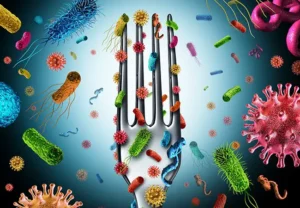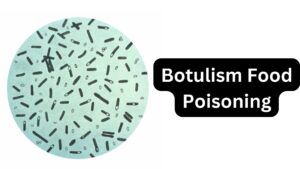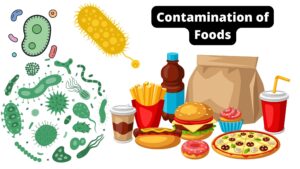- The contents of shell eggs are typically sterile, notwithstanding the possibility of vertical contamination.
- Nonetheless, contamination happens routinely during the processing of egg products due to the contact of the eggshells with the egg content during the egg breakage step.
- The microbiological contamination may cause sanitation and/or spoiling issues. Salmonella Enteritidis, one of the most important organisms involved in outbreaks involving shell eggs and egg products, is the primary hygienic concern.
- Even though egg safety is still a major problem, the sanitary risk has been significantly reduced due to the enhancement of hygienic measures in the breeding environment, the pasteurisation of egg products, and the observance of the cold chain for their storage.
- Nevertheless, microbial deterioration of eggs and egg products can still result in substantial economic losses.
- In order to meet the ever-changing consumer demand for natural, safe, nutritious, and delicious foods, preventing egg product spoiling is a significant concern.
Contamination of Eggs
Eggs, in their natural state, are typically sterile. However, contamination can occur after they are laid due to a variety of reasons. It is essential to understand these potential sources of contamination in order to minimize the risk of egg spoilage. The following factors contribute to the contamination and subsequent spoilage of eggs:
- Fecal Matters of the Chicken: One common source of egg contamination is the presence of fecal matter from the chicken. During the laying process, eggs can come into contact with feces, especially if the hen’s hygiene is not properly maintained. Fecal matter may contain bacteria such as Salmonella, which can penetrate the eggshell and lead to spoilage.
- Specks of Dirt or Materials Used for the Cage or Nest: Eggs can also become contaminated by small particles of dirt, dust, or debris present in the chicken’s environment. This can occur if the cage or nest material is not clean or if the chicken has access to unsanitary areas. These contaminants can introduce harmful microorganisms to the eggshell, promoting spoilage.
- Water Used During Washing of Eggs: Eggs are often washed to remove any visible dirt or contaminants from the shell. However, if the water used for washing is contaminated, it can actually introduce harmful bacteria onto the eggshell instead of removing them. This contaminated water can seep through micro-cracks or pores in the shell, leading to spoilage.
- Equipment Used During Processing and Handling: Improperly cleaned or sanitized equipment used during egg processing and handling can be a significant source of contamination. If utensils, conveyor belts, or egg grading machinery are not adequately disinfected, they can transfer bacteria from previously contaminated eggs to fresh ones. Cross-contamination can occur at any stage of the processing and handling, contributing to spoilage.
- Materials Used to Pack the Eggs: Packaging materials play a crucial role in protecting eggs from external contamination. However, if the packaging materials are not of good quality or are contaminated themselves, they can introduce bacteria or other contaminants to the eggs. This can compromise their freshness and accelerate spoilage.
- Temperature Used During Storage: Proper storage temperature is vital for preserving the quality and safety of eggs. If eggs are stored at temperatures that are too high, bacteria can multiply rapidly, leading to spoilage. Conversely, if eggs are stored at temperatures that are too low, the quality of the egg can deteriorate, resulting in changes such as albumen thinning or yolk freezing.
- Presence of Eggshell Cracks or Micro-cracks: Eggshell integrity is critical in preventing the entry of bacteria and contaminants into the egg. Cracks or micro-cracks in the eggshell can provide a pathway for microorganisms to penetrate the protective barrier. Once inside, these contaminants can promote spoilage and compromise the safety of the egg.
By understanding the potential sources of contamination and implementing appropriate preventive measures, egg producers and handlers can minimize the risk of spoilage and ensure the delivery of safe and high-quality eggs to consumers. Good hygiene practices, regular equipment cleaning, proper storage conditions, and thorough inspection of eggshell integrity are essential steps in maintaining egg freshness and reducing contamination-related spoilage.
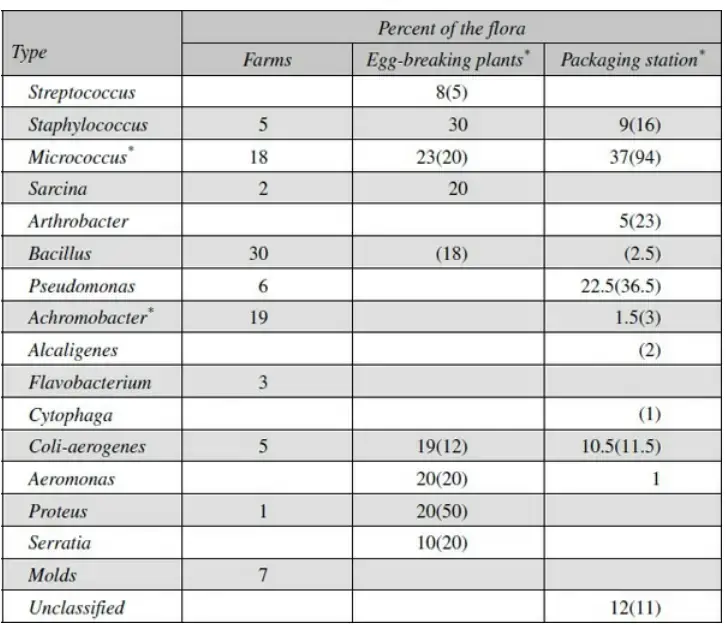

Spoilage of eggs
1. Contamination of eggs
- Freshly laid eggs are sterile, however the egg shell quickly becomes contaminated with faeces from the hen’s nest, washing water, handling, and other storage materials.
- According to reports, the total number of microorganisms per egg shell ranges between 102-107, with an average of 105.
- Salmonella species can be detected on egg shells and within eggs.
2. Non-microbial spoilage of eggs
- These include moisture loss and, thus, weight loss during long-term storage.
- During long-term preservation, egg contents also undergo physical changes.
- They include egg white thinning and the rupture of the yolk membrane.
- As the membrane of the yolk weakens and breaks, the yolk becomes flat and uniformly mixed with the egg white.
3. Microbial spoilage of eggs
- Microorganisms must infect the shell, penetrate the shell’s pores and inner membrane, reach the eggwhite and yolk, and develop there in order to cause shell deterioration.
- Certain germs are unable to develop in egg white, yet they multiply fast in egg yolk.
- Changes in storage temperature enhance organism penetration through shell, hence promoting microbial deterioration.
Bacterial spoilage of eggs
Bacteria are the most prevalent organisms that cause spoiling. Bacteria cause egg to deteriorate. When bacteria multiply inside an egg, they breakdown the contents and produce byproducts. Gram-positive bacteria such as Staphylococcus, Streptococcus, Aerococcus, and micrococcus dominate the eggshell’s microflora. Gram-negative bacteria like Salmonella and Escherichia are additional minor pollutants.
1. Green rot
- This condition is due to Pseudomonas uorescence.
- When exposed to UV light, egg whites that are green glow.
- In the later stages of spoiling, the egg yolk decomposes and conceals the green hue of the egg white.
- The odour is absent, fruity, or sweet.
2. Colorless rot
- Possible causes include Pseudomonas, Acetobacter, Acinarobacter, and coliform.
- In the later stages of spoiling, egg yolk decomposes or forms incrustations.
3. Black rot
- It is caused by Proteus, Pseudomonas, and occasionally aeromonas.
- The blackening and subsequent disintegration of egg yolk gives the entire egg a murky brown appearance.
- Because of H2S, odour is putrefied.
4. Pink rot
- Pseudomonas typically causes it during the later stages of green rot.
- They are identical to colourless decay, except that the egg yolk and white are coloured pink.
5. Red rot
- It is brought about by Serrotia marcescens.
- These eggs are identified by a rod-shaped separation between the egg white and the surface of the yolk, as well as an ammoniac, or putrefied, odour.
6. Custard rot
- In this rot, the egg yolk is encrusted with a substance resembling custard and occasionally has green to olive pigmentation.
- The albumin became thin and orange in hue.
- Citrobacter and Proteus vulgaris are to blame for this sort of rotting.
Fungal spoilage of Egg
Egg-spoiling fungi include Penicillium, Sporotrichum, Mucor, Botrytis, Alternaria, and Thamnidium, among others. Eggs spoiled by fungi progress through phases of mould development. Spot-on moulding. Fungal decaying
1. Pin spot molding
- In this instance, small, dense colonies of mould form on the shell and, typically, just inside.
- The hue of pin dots differs depending on the type of mould. Cladosporium, for instance, produces black spots while Sporotrichum produces pink spots.
2. Superficial fungal spoilage
- This occurs when eggs are stored in a humid environment.
- In this instance, moulds on shell seem as whiskers.
3. Fungal rotting
- It is the final stage of mould decay.
- In this instance, fungal mycelium grows via holes and crevices in the shell.
- It is possible for egg white to gelatinize and for coloured spots to form.
- Hypha of mould penetrates the membrane of the yolk and ruptures it, causing the yolk to mix with the white.
Monitoring and reducing the spoilage of egg
- Diverse strategies have been investigated for reducing the quantity of eggshell contamination and improving the egg’s inherent defences. They consist of both:
- Step upstream – This involves hen selection, the enhancement of breeding procedures, and farm management.
- Downstream steps – This involves the packaging, transportation, and storage of eggs.
- The type of hen housing system influences the microbiota and the amount of cracked or broken eggs.
- The design of conventional cages has been adjusted for optimal hen performance, with the added benefit of hygienic egg quality.
- Therefore, care should be used while building cages to ensure the highest level of egg hygiene.
- To decrease contamination, egg collection techniques on the farm, as well as sorting, packing, storage, and delivery, must be enhanced.
- Cross-contamination must be avoided by preventing worker and environmental contamination.
- It is important to improve egg storage conditions, including temperature and time requirements.
- Eggs that are refrigerated effectively prevent the liquification of egg white, the deterioration of the vitelline membrane, and the subsequent microbial development.
- Egg candling is a crucial process in controlling the microbiological quality of eggs in packaging centres.
- Due to the contamination of the albumen by Pseudomonas, UV light has proven to be particularly effective at detecting the fluorescent pigment.
- In the egg product sector, germs are primarily destroyed by heat treatments at temperatures between 65 and 68 degrees Celsius for 5 to 6 minutes for both whole egg and egg yolk.
- Due to the higher thermal sensitivity of egg white proteins, egg white treatments are milder (about 55 to 57°C for 2 to 5 minutes).
- Freezing and drying are effective techniques for reducing spoilage.
- Eggs treated with peracetic acid in solution with hydrogen peroxide and acetic acid.
- The methods used to forecast spoiling during the production of egg products can be split into two categories:
- those that target bacteria and those that target spoiling indicators (end product compounds coming from the bacterial metabolism).
- Alternative techniques have been developed to locate spore-forming bacteria amid the diverse whole egg flora. These techniques are based on molecular tools like PCR.
- The proliferation of spoilage microorganisms responsible for the deterioration of egg products is studied using optical techniques (red LED light) in other alternative methodologies.
Preservation of Egg and Egg products from microbial spoilage
- Because eggs are so perishable, there has been tremendous interest in methods of egg preservation.
- “What manufacturer would be so reckless as to attempt to package a perishable product in a semipermeable membrane within a fragile, porous shell and distribute and advertise it under uncontrolled conditions?” Board (1969) continues, “This appears to be what the hen did.”
- The egg has multiple defence mechanisms against microbial invasion. The shell and the thin layer of proteinaceous material on its surface, known as the cuticle or bloom, serve as the first line of defence and deter penetration.
- However, the shell is permeable to facilitate gas exchange during embryogenesis. Additionally, the membranes within the shell function as a mechanical barrier.
- This barrier is likely transient and provides no protection against the penetration of mould hyphae through the shell and membrane pores.
- This fact underlines the need to keep eggs so as to prevent the accumulation of moisture on the shell’s surface.
- A quick shift in storage temperature may allow bacteria to overcome the shell’s and membrane’s physical barrier.
- If a heated egg is placed in a cold environment, for instance, microorganisms on the shell surface may be sucked in through the pores when the egg contents contract.
- As membranes age, they undergo alterations that promote bacterial proliferation.
- The rates of physical and chemical changes in eggs are dependent on the duration and temperature of storage, the relative humidity, and the atmospheric composition.
- Numerous investigations have demonstrated that, in addition to the physical barrier of the shell and its membranes, albumen is an insufficient growth substrate for many microorganisms.
- Low levels of simple nitrogenous compounds; a pH of 9 to 10 that may be reached during storage; apoprotein, which binds riboflavin; avidin, which binds biotin; antiproteolytic factors, which may prevent bacterial proteinases from releasing nitrogenous compounds necessary for growth; conalbumin (ovotransferrin), which chelates iron; and lysozyme, an enzyme that degrades the cell walls of gram-positive bacteria.
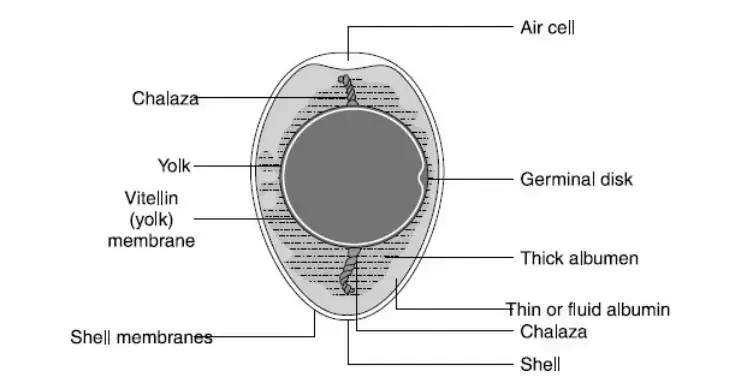
1. Asepsis
- Care is taken to minimise the contamination of the exterior of the shell by hen faeces and nest dirt.
- When eggs are broken for drying or freezing, care is taken to discard any that have undergone microbial growth and to reduce contamination by cleaning and sanitising the equipment.
2. Removal of Microorganisms
- Due to the fact that soiled eggs attract a lower price than clean ones, numerous methods for removing soil have been attempted.
- Dry cleaning, such as sandblasting, eliminates both soil and bloom (mucin). Warm, simple water washes away dirt, the bloom, and a portion of the microorganisms, but allows bacteria to enter the egg through the pores in the shell.
- Unless safeguards are followed, the wash water will accumulate spoilage bacteria, leading to an increase in contamination during the washing process.
- Experiments indicate that hand-washed eggs are more susceptible to rotting than unwashed eggs, and that machine-washed eggs are more susceptible to rotting than hand-washed eggs.
- The quantity of decay depends on the type of washing machine and the type of washing solution.
- Attempts to reduce contamination with rot bacteria by cleaning the machines and disinfecting with a 1% hypochlorite solution have not always been successful, but the use of this disinfectant solution as the wash water has decreased the proportion of rots in the washed eggs.
- The use of 1% to 3% acetic acid was effective in eliminating flora, but resulted in a decrease in egg quality and shell thickness.
- In washing solutions, lye, acids, formalin hypochlorites, quaternary ammonium compounds, diverse detergents, and detergent-sanitizer combinations have been utilised.
- Depending on the used ingredients, these solutions are utilised at temperatures ranging from 32,2 to 60 degrees Celsius.
- It is necessary to use a warm washing solution to avoid the liquid from being pulled into the egg. A correctly functioning mechanical egg washer will eliminate nearly all shell flora.
3. Use of Heat
- The heat coagulability of the egg white largely determines the maximum heat treatment that can be applied to shell eggs.
- Salton et al. (1951) determined the maximum time at different temperatures for heating in water to just avoid coagulation, such as 800 seconds at 57.5 degrees Celsius; 320 seconds at 60 degrees Celsius or above resulted in some coagulation of the white when heat treatments were used to control rotting.
- By heating at 60 degrees Celsius for 320 seconds, for instance, the rotting was effectively controlled. Heating with water was more effective than heating with oil.
- Heating shell eggs in oil for 10 minutes at 60 degrees Celsius or in water for 30 minutes at 54.4 degrees Celsius; heating egg contents at 61.7 degrees Celsius for 30 minutes; immersion of shell eggs in boiling water for a few seconds or in hot oil (57.2 degrees Celsius) with or without a vacuum; and immersion of eggs in a hot detergent-sanitizer solution (43.3 to 54.4 degrees Celsius) are all suggested treatments (the sanitizer being a quaternary ammonium compound).
- A method of thermostabilization that involves dunking eggs in hot water minimises evaporation of moisture from the egg by coagulating the outermost portion of the egg albumen. The following are the heat treatments used in the United States to eliminate salmonellae:
- Whole egg liquid, 60 degrees Celsius for at least 3.5 minutes.
- plain yolk liquid, 61.1 degrees Celsius for at least 3.5 minutes or 60 degrees Celsius for at least 6.2 minutes.
- yolk with carbohydrate, 63.3 degrees Celsius for at least 3.5 minutes or 62.2 degrees Celsius for at least 6.2 minutes.
- yolk with salt, 63.3 degrees Celsius for at least 3.5 minutes or 62.2 degrees Celsius for at least 6.2 minutes.
- Similar, although with subtle variations, are the treatments utilised in other nations. Pasteurization is necessary for the majority of egg products.
- One exception is the use of salt yolk in salad dressings. If this product contains at least 1.4% acetic acid, it is exempt (pH 4.1 or lower).
- Due to the heat-coagulability of eggs, a stabilising procedure is necessary prior to pasteurisation. This entails the addition of aluminium salts and pH correction.
4. Use of Low Temperatures
The most prevalent method for preserving eggs is the application of low temperatures, such as chilling temperatures for shell eggs and freezing temperatures for egg “meats.” Shell eggs may be chilled in conjunction with oiling, gas storage, or chemical preservative treatment.
a. Chilling
- The majority of eggs are preserved by refrigeration. On the basis of their general look and the results of candling, they are chosen for storage.
- To examine an egg for flaws such as cracks, rots, moulds, blood, a developing embryo, a crusted or sided yolk, a poor white, or a huge air cell, it is held and turned in front of a light.
- After creation, the eggs should be chilled as soon as possible and stored at a temperature and relative humidity dependent on the anticipated duration of storage.
- The lower the relative humidity falls below 99.6 percent, the faster the egg loses moisture and, consequently, weight, and the larger the air cell. The greater the relative humidity, the greater the likelihood of microbiological egg deterioration.
- The higher the temperature is above 1.67 degrees Celsius, the faster the entrance of microorganisms into the egg and their subsequent growth, as well as the bigger the physical and chemical changes, such as the thinning of the white and the weakening of the membrane around the yolk.
- A temperature range of 1.7 to 0.55 degrees Celsius and a relative humidity range of 70 to 80 percent are suggested for commercial storage of products for six months or longer.
- Air circulation in the storage chamber is necessary to maintain the proper relative humidity surrounding the eggs, and a steady temperature is required to prevent condensation on the eggshells.
- Special treatments can increase the quality of eggs during refrigeration storage. The usual practise of impregnating eggshells with odourless and colourless mineral oil keeps away moisture, inhibits desiccation and air penetration, retains carbon dioxide, and slows physical and chemical changes within the egg.
- Eggs are lightly sprayed with the oil, particularly eggs that will be held commercially for extended periods, with no discernible effect on the rates of microbial transformations within the egg.
b. Freezing
- Egg “meats” or “pulp” are frozen with the selection and preparation of the egg contents presenting the greatest bacteriological challenges.
- Similar to other frozen items, frozen eggs are identical to unfrozen eggs. Many of the eggs that are broken for freezing or drying are flawed in some way that decreases their grade as shell eggs but does not impact the quality of the contents, for example, they are undersized, filthy, cracked, or have a thin shell.
- The eggs are first picked by candling, then mechanically washed with a final rinse of 200 to 500 ppm chlorine (iodine is also effective), and then broken on automatic breaking equipment.
- Before mixing or “pooling” large amounts, the use of automatic machine breaking necessitates stringent control over the quality of the whole eggs and examination of the broken eggs. The eggs are broken, and their contents are poured into glasses for inspection.
- During inspection, the motion of the cup separates the yolks and whites. Sanitation throughout the breaking process and the meticulous removal of damaged eggs have a significant impact on the types and numbers of germs present in frozen products.
- Every piece of equipment that comes into contact with shell eggs or their contents must be cleaned and sanitised daily or more frequently.
- Egg meats, whether whole or separated, are filtered to remove shell fragments and stringy material (chalazae), combined or churned, standardised for solids content, and frozen in 30- or 50-lb tin cans or other containers, typically by a rapid-freezing method.
- Separately frozen and stored egg yolks produce a jelly that does not become liquid upon thawing. This problem is avoided by including at least 5 percent of sugar, salt, or glycerol prior to freezing.
- The eggs are stored between 17.8 and 20.5 degrees Celsius. If sufficient safeguards are not taken, frozen eggs may contain up to millions of germs per gramme.
- This may be due to the usage of highly contaminated egg pulps, contamination from shell fragments and equipment in the breaking room, and growth prior to freezing.
- Bacteria of the genera Alcaligenes, Proteus, and Flavobacterium are expected to be abundant, as are Pseudomonas organisms and those of the genera Alcaligenes and Proteus.
- There are less Gram-positive cocci, rods, and coliforms on the eggshell, as well as possible anaerobes and other bacterial pollutants.
- Salmonellae may occasionally be present in eggs from infected hens or contamination. There are likely to be a few survivors of each type of organism present after the freezing procedure.
- A small number of each type of organism present are likely to survive, notwithstanding their abundance. The numbers decline gradually during storage in a frozen state.
- If thawing is performed at a temperature that is too high, or if thawed eggs are held for too long before usage, psychrotrophic bacteria will proliferate and increase the bacterial count.
- The duration of thawing at temperatures over 2 to 3 degrees Celsius should be as brief as possible. For 30-pound cans, some proposed combinations of time and temperature are 10 to 15 C for 8 to 15 hours or 2 to 3 C for 48 to 72 hours.
5. Preservation by Drying
- The concepts involved in the production of whole egg pulp, egg white, and egg yolk for drying are identical to those previously mentioned in the preparation of same materials for freezing.
- Before drying, egg white requires further treatment to preserve its whipping characteristics.
- Prior to drying, one of the Browning or Maillard reaction’s reactants, glucose, must be eliminated.
- Several ways for removing glucose have been proposed, such as fermentation by group D streptococci, Enterobacter aerogenes, or Saccharomyces cerevisiae and an enzymatic process including glucose oxidase.
- Glucose is transformed into gluconic acid, with hydrogen peroxide serving as the oxygen donor, in the second method. A cold desugaring procedure utilising glucose oxidase at 10 degrees Celsius has the benefit of yielding a product with a low bacterial count.
- In the majority of egg-drying operations in the United States, liquid is sprayed into a stream of dry, heated air in a spray dryer.
- The liquid egg is passed over a heated roller or drum, with or without suction, in the roller or drum process. By using open pans, as the Chinese do, or by using a belt system in which the egg liquid travels through a heated tunnel, air-drying is achieved (60 to 71.1 C).
- Egg white is dried using spray drying or pan drying mixed with tunnel drying. Previously, eggs were dried to a moisture content of approximately 5 percent; however, the keeping quality of dried white or whole egg improves as the moisture content decreases near 1 percent, and this trend is expected to continue.
- The most prevalent drying equipment is comparable to the spray-drying equipment used to dry milk in the dairy sector, and similar issues are visible.
- The bacteriological condition of the air to which the product is exposed throughout the drying operation is a crucial consideration in both procedures.
- Utilizing absolute filters and preheating the air have had substantial effects. In addition, the heat supplied during drying cannot be relied upon to eliminate all bacteria in the finished product or even as a method of pasteurisation.
- Consequently, monitoring or pre-heating of the original product is an essential precaution.
- Before drying, whole egg and yolk products can be pasteurised, whereas egg white is typically subjected to a further heat treatment.
- The bulk containers of egg white are exposed to temperatures between 52 and 54 degrees Celsius for seven to ten days, depending on the final product’s moisture content.
- The number of microorganisms per gramme in dried eggs can range from a few hundred to over 100 million, depending on how the eggs were broken and handled.
- The same factors account for the high amount of frozen egg packages. The drying procedure may lower the number of microorganisms in the egg by a factor of ten to one hundred, yet still let a substantial amount to survive.
- Micrococci*, streptococci (enterococci), coliform bacteria, salmonellae species, spore-forming bacteria, and moulds have all been identified in dried eggs.
- Cocci and gram-positive rods are more likely to be present due to contamination from the shell during breaking, from handlers, or from equipment than from damaged eggs.
- Salmonellae can be transmitted by infected chickens; nevertheless, they are uncommon, and the majority of consumers want “salmonella-free” products.
- When egg white has been fermented prior to drying, the dried product may include a significant number of microorganisms.
- Egg products that have been adequately dried contain insufficient moisture for the growth of germs. During storage, the number of organisms in dry egg will decrease, initially more swiftly and then gradually.
- As storage continues, a greater proportion of the survivors will consist of desiccation-resistant organisms, such as micrococci* and spores of bacteria and moulds.
- The more the egg’s moisture content has been lowered from 5 percent, the quicker bacteria will die.
6. Use of Preservatives
- Eggs may include preservatives on their shells, in the air around them, or in their packaging or wrapping.
- To aid in their preservation, a vast array of chemicals have been put to the surface of egg shells or employed as packaging material around eggs.
- Waxing, lubricating the shells, and other forms of sealing are examples of substances that are utilised largely to keep the shell dry and prevent the entry of oxygen and the escape of carbon dioxide and moisture.
- Other compounds limit microbe growth, and some are germicidal. Salt, lime, sand, sawdust, and ashes are utilised for the dry packing of eggs in the home.
- Immersion in water glass, a sodium silicate solution, has long been a successful method of home preservation.
- The inhibitory nature of the solution is due to its alkalinity. Borates, permanganates, benzoates, salicylates, formates, and a multitude of other compounds have also been attempted as inhibitory agents.
- There have been references to the use of warm or hot germicidal solutions, such as hypochlorites, lye, acids, formalin, quaternary ammonium compounds, and detergent-sanitizer combinations, in the washing of eggs.
- Sealing the shell with a dimethylolurea solution has been shown to effectively prevent mould growth.
- By treating the flats and fillers of storage containers with a mycostatic or mold-inhibiting chemical, certain attempts have been made to prevent egg deterioration during storage caused by moulds.
- With some success, sodium pentachlorophenate and similar substances have been utilised. It has been claimed that fumigating eggs with gaseous ethylene oxide before to storage protects them from bacterial deterioration.
- Only carbon dioxide and ozone are given to the atmosphere around eggs to increase their keeping quality, but nitrogen has been used experimentally.
- Regarding the ideal concentration of carbon dioxide in the air for this purpose, recommendations vary.
- A modest concentration, such as 2.5%, for instance, inhibits the physical and chemical changes in the egg that accompany the rise in pH when carbon dioxide escapes the egg, but has little influence on microbial development, especially mould formation.
- Concentrations as high as 60 percent will significantly delay microbiological deterioration, particularly if the temperature is close to freezing, even if the relative humidity approaches saturation, but the white gets thinner and the flavour becomes disagreeable.
- Thus, the recommendations range from 0.5% to 0.6% at 1°C and from 2.5% to 5% at 0°C, with a maximum of 15%.
- Concerning ozone’s usefulness, there has been some dispute. It has been claimed that 0.6 ppm to 1.5 ppm of ozone (for clean eggs) and 3.5 ppm of ozone (for dirty eggs) at 0.55 degrees Celsius and 90 percent relative humidity will keep eggs fresh for eight months and will not harm them, but some researchers assert that 0.5 to 1.5 ppm have little effect on microorganisms.
- It has been claimed that low concentrations of ozone improve the flavour of kept eggs due to the deodorising impact of the gas.
7. Use of Irradiation
- Experiments suggest that pathogens (such as Salmonella) in liquid, frozen, and dry eggs can be rendered inactive by ionising radiation. However, harm has also been documented at relatively low doses.
References
- Al-Bahry S.N., Mahmoud I.Y., Al-Musharafi S.K., Al-Ali, M. A. (2012). Penetration of Spoilage and Food Poisoning Bacteria Into Fresh Chicken Egg : a Public Health Concern. Global Journal of Bio-Science & Biotechnology, 1(1), 33–39.
- Corry, J. E. L. (2006). Microbiological analysis of eggs and egg products. In Microbiological Analysis of Red Meat, Poultry and Eggs: A volume in Woodhead Publishing Series in Food Science, Technology and Nutrition. https://doi.org/10.1533/9781845692513.183
- Food Microbiology, William C. Frazier; Fourth Edition.pdf. (1995).
- Gherardi, S. R. M., Santos, B. M., Silva, F. A., Stringhini, J. H., & Café, M. B. (2015). Physical and Chemical Changes and Functional Properties of White Eggs as a Function of Time and Conditions of Storage. (August 2017). https://doi.org/10.13140/RG.2.2.21110.09282
- Kumari, A., Kumar Tripathi, U., Maurya, V., & Kumar, M. (2020). INTERNAL QUALITY CHANGES IN EGGS DURING STORAGE. Retrieved from www.ijset.net
- MAYES, F. J., & TAKEBALLI, M. A. (1983). Microbial Contamination of the Hen’s Egg: A Review. Journal of Food Protection, 46(12), 1092–1098. https://doi.org/10.4315/0362-028x-46.12.1092
- Mendes, F. R., Andrade, M. A., Barcellos Café, M., Santos, J. S., Ribeiro Lacerda, M. J., Stringhini, J. H., … Leandro, M. (2012). Physical and chemical quality of sanitized commercial eggs experimentally contaminated with Pseudomonas aeruginosa and refrigerated during storage. Retrieved from www.sbz.org.br
- https://epashupalan.com/10453/poultry-farming/microbial-spoilage-of-eggs-and-preservation-of-eggs-from-spoilage/
- https://microbenotes.com/microbial-spoilage-of-egg-and-egg-products/
- https://gcwgandhinagar.com/econtent/document/1587965185microbiology%20of%20egg%20and%20egg%20products.pdf
- https://www.studocu.com/in/document/university-of-mumbai/microbiology-immunology-and-plant-physiology/contamination-spoilage-and-preservation-of-eggs-final-draft/3636211
- https://www.onlinebiologynotes.com/microbial-spoilage-of-eggs-and-methods-of-preservation/
